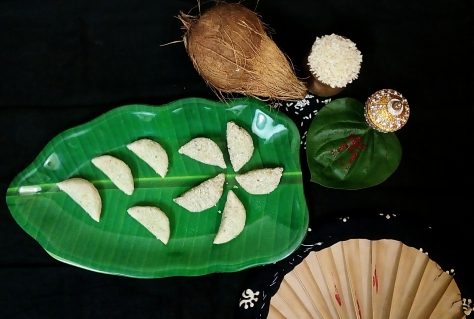Shubho Nababorsho/ Happy New Year…to all my visitors !
You might have heard about Chondropuli if you are a Bengali, however it is also possible that what you are thinking about is actually Gujjiya or Puli, the popular Indian sweet made during the Indian festivals of Holi and Diwali. For other Indians, who are not Bengalis or who are not much familiar with the Bengali ways, chondropuli or chandropuli might sound something shaped like a moon…right??😀😀 Yes you are partially right…it is indeed a half-moon shaped sweet dumpling…But for me, it is a sweet that I have grown up with, in my home. It is a legacy that is passed on by my great grandmother to my grandmother to my mother and to us finally. It runs like a custom in our family & extended family and almost every womenfolk in our family has mastered the art of making it with of course, slight variations incorporated into its preparation through their own creativities. I would define this dessert as a sweet dumpling which is made specially during auspicious occasions and celebrations in our household. It has become a sort of customary in our house to prepare this dish on the occasion of Vijaya Dashami for the guests and visitors who come to convey their sweet greetings of Shubho Bijoya, just after the conclusion of Durga Puja. Although I do not properly remember when exactly I had tasted it for the first time in my life, yet I remember the fact that my late grandmother was the first person to introduce this delicacy to us. She had a special interest in the preparation of this particular sweet, and used to make chondropulis that would just taste divine. The sweet is a pleasure to bite in having a smooth texture of chhena with a slight crunch of coconuts and sugar granules outside and then unravelling the moist khoya inside which emits a mild aroma of rose water that just arrests your senses. Every family member, relatives and friends would praise her for this dish and wanted to have more of it. Remembering all this, I just could not stop myself from introducing this heavenly sweet to you, which by and large had been our family legacy till now, though I guess that there may be a lot many Bengalis out there who are already familiar with this traditional Bengali sweetmeat.Today on the ocassion of Poila Baisakh, we relished this homely sweet after the elaborate nababorsho platter with all the culinary memories of my late grandmother who passed away last year.
This sweet is slightly healthier compared to few other traditional sweets since this is made from pure chhena, doesn’t use any flour & require no frying, along with the goodness of dry fruits & coconut which are again protein-rich ingredients that are also good for the would be mothers to indulge in. So, prepare it and savour its taste without feeling much guilty and I am sure you will be a fan of it.

RECIPE:
Ingredients:
Cottage cheese / Chhena : 250 g
Coconut (grated) : 1 small coconut
Sugar: 3/4 cup
Cardamom ( ground ) : 12- 13 approx.
Khoya: 50 g
Dry fruits (Cashews/pistachio/almonds/raisins ) chopped : 1/3-1/2 cup
Rose water : 1/2 tsp
Preparation:
- Melt khoya in a pan over low flame with small amount of water or milk.
- Add sugar and keep stirring continuously till the sugar melts completely.
- Add dry fruits, cardamom powder, rose water and stir well.
- Keep stirring until the mixture starts leaving the sides of the pan. Do not overdo, keep the mixture little moist for better taste.
- Switch off the flame and keep it aside.
- Now take grated coconut and chhena in a blender and give it a short pulse to make it into a smooth mixture till no granules are left. Also you can knead it using your hand if you are using powdered desiccated coconut instead of grated coconut, otherwise the outer coat will become coarse instead of smooth.
- Take sugar in a pan over low flame, melt it to make a thick syrup and then add your mixture to it. Keep stirring till everything blends into a smooth mixture. Add cardamom powder and mix well. (Note: Thicken your sugar syrup properly before adding the chhena mixture to avoid any contact with water or else your chhena will become granular and difficult to bind).
- Take the mixture down from the flame when it starts leaving the sides of your pan.
- Make small roundels out of the mixture, take small amount of khoya mixture in the centre and fold the roundels into semi-circles. (Note: Do this step as fast as possible to avoid any hassle).
- Seal the ends in the form of gujjiya or half moon shaped dumplings.
- Dust the surface of the dumplings with sugar granules and these are ready for a bite.
- Serve fresh or store them outside for 1-2 days or in the refrigerator for a week to be served later.




Wonderful post! Nice to know about your family recipe & traditions followed during your New Year, thank you so much for sharing.
LikeLiked by 1 person
Thank you so much…My pleasure !!
LikeLiked by 1 person
This is something new to me…and a dish with my favorite ingredients ! This is definitely a MUST try !!
LikeLiked by 1 person
Thanks !! Try this….I bet you’ll like it.
LikeLike